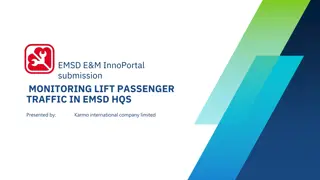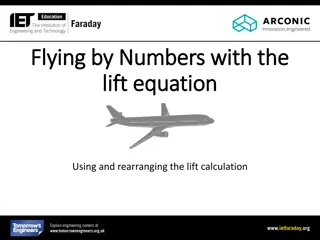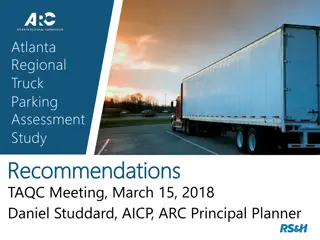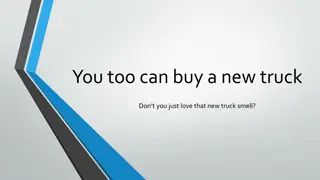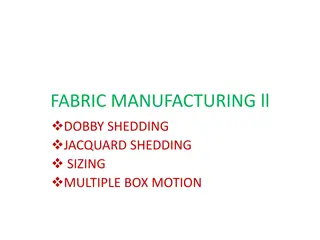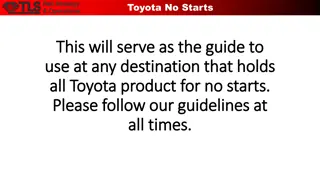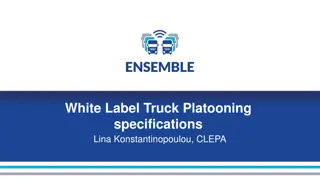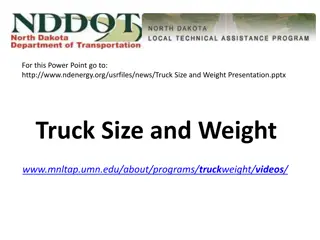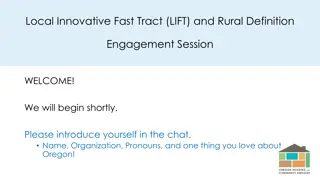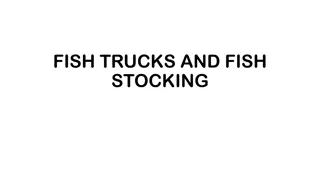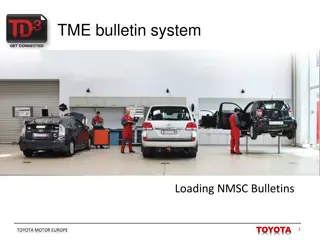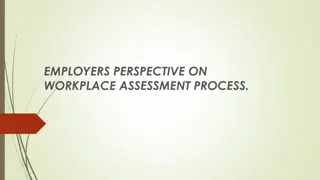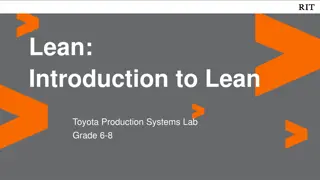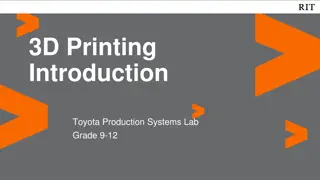
TOYOTA 7BRU18, 7BRU23, 7BDRU15, 7BSU20, 7BSU25 Reach Lift Truck Service Repair Manual Instant Download
Please open the website below to get the complete manualnn//
Download Presentation

Please find below an Image/Link to download the presentation.
The content on the website is provided AS IS for your information and personal use only. It may not be sold, licensed, or shared on other websites without obtaining consent from the author. Download presentation by click this link. If you encounter any issues during the download, it is possible that the publisher has removed the file from their server.
E N D
Presentation Transcript
SERVICE MANUAL Reach Lift Truck Models: 7BRU18 7BRU23 7BDRU15 7BSU20 7BSU25 24 Volt Models - Serial No. 21,000 and Up 36 Volt Models - Serial No. 32,000 and Up 00700-CL220-01 Issued: 6/1/04
Toyota Reach Service Manual Table of Contents Table of Contentsi: How to Use This Manual. . . . . . . . . . . . . . . . . . . . . . . . . . . . . . 1-1 Map of the Manual . . . . . . . . . . . . . . . . . . . . . . . . . . . . . . . . . . . . . . . . .1-2 Manual Design . . . . . . . . . . . . . . . . . . . . . . . . . . . . . . . . . . . . . . . . . . . .1-3 START Page. . . . . . . . . . . . . . . . . . . . . . . . . . . . . . . . . . . . . . . . . . . . . . .1-5 Safety. . . . . . . . . . . . . . . . . . . . . . . . . . . . . . . . . . . . . . . . . . . . 2-1 Definitions . . . . . . . . . . . . . . . . . . . . . . . . . . . . . . . . . . . . . . . . . . . . . . .2-2 General Safety. . . . . . . . . . . . . . . . . . . . . . . . . . . . . . . . . . . . . . . . . . . . .2-3 Battery Safety . . . . . . . . . . . . . . . . . . . . . . . . . . . . . . . . . . . . . . . . . . . . .2-7 Static Safety . . . . . . . . . . . . . . . . . . . . . . . . . . . . . . . . . . . . . . . . . . . . . 2-11 Jacking Safety. . . . . . . . . . . . . . . . . . . . . . . . . . . . . . . . . . . . . . . . . . . . 2-13 Tie-down for Transport . . . . . . . . . . . . . . . . . . . . . . . . . . . . . . . . . . . . . 2-14 Welding Safety . . . . . . . . . . . . . . . . . . . . . . . . . . . . . . . . . . . . . . . . . . . 2-15 Systems Overview. . . . . . . . . . . . . . . . . . . . . . . . . . . . . . . . . . . 3-1 Vehicle Specifications . . . . . . . . . . . . . . . . . . . . . . . . . . . . . . . . . . . . . . .3-2 General System Data. . . . . . . . . . . . . . . . . . . . . . . . . . . . . . . . . . . . . . . .3-3 Modes of Operation . . . . . . . . . . . . . . . . . . . . . . . . . . . . . . . . . . . . . . . . .3-6 Scheduled Maintenance . . . . . . . . . . . . . . . . . . . . . . . . . . . . . . 4-1 Maintenance Guidelines . . . . . . . . . . . . . . . . . . . . . . . . . . . . . . . . . . . . .4-2 Daily or Every 8 Operating Hours . . . . . . . . . . . . . . . . . . . . . . . . . . . . . .4-3 Monthly or Every 200 Operating Hours . . . . . . . . . . . . . . . . . . . . . . . . . .4-4 Semi-annually or Every 1000 Operating Hours . . . . . . . . . . . . . . . . . . . .4-5 Annually or Every 2000 Operating Hours . . . . . . . . . . . . . . . . . . . . . . . .4-6 Lubricants . . . . . . . . . . . . . . . . . . . . . . . . . . . . . . . . . . . . . . . . . . . . . . .4-7 Lubrication and Inspection Points . . . . . . . . . . . . . . . . . . . . . . . . . . . . . .4-9 00700-CL220-01 Issued: 6/1/04 i
https://www.ebooklibonline.com Hello dear friend! Thank you very much for reading. Enter the link into your browser. The full manual is available for immediate download. https://www.ebooklibonline.com
Table of Contents Toyota Reach Service Manual Troubleshooting . . . . . . . . . . . . . . . . . . . . . . . . . . . . . . . . . . . . 5-1 How to Use This Chapter . . . . . . . . . . . . . . . . . . . . . . . . . . . . . . . . . . . . 5-2 Electrical Troubleshooting Guidelines . . . . . . . . . . . . . . . . . . . . . . . . . . 5-3 Shorts to Frame Test . . . . . . . . . . . . . . . . . . . . . . . . . . . . . . . . . . . . . . . 5-4 Hydraulic Troubleshooting Guidelines . . . . . . . . . . . . . . . . . . . . . . . . . . 5-8 Definitions. . . . . . . . . . . . . . . . . . . . . . . . . . . . . . . . . . . . . . . . . . . . . . . 5-9 Electrical Connector Locator Chart. . . . . . . . . . . . . . . . . . . . . . . . . . . . 5-10 Electrical Connector Locator Photos. . . . . . . . . . . . . . . . . . . . . . . . . . . 5-12 List of Troubleshooting Flowcharts. . . . . . . . . . . . . . . . . . . . . . . . . . . . 5-17 Electrical Codes and Tests . . . . . . . . . . . . . . . . . . . . . . . . . . . . 6-1 Modes of Operation . . . . . . . . . . . . . . . . . . . . . . . . . . . . . . . . . . . . . . . . 6-2 Self-diagnosis Mode . . . . . . . . . . . . . . . . . . . . . . . . . . . . . . . . . . . . . . . . 6-4 Analyzer (AnL) Mode . . . . . . . . . . . . . . . . . . . . . . . . . . . . . . . . . . . . . . . 6-5 Calibrate (Calibrte) Mode . . . . . . . . . . . . . . . . . . . . . . . . . . . . . . . . . . . . 6-6 Configure (Configur) Mode . . . . . . . . . . . . . . . . . . . . . . . . . . . . . . . . . . . 6-8 Tuning (Tuning) Mode . . . . . . . . . . . . . . . . . . . . . . . . . . . . . . . . . . . . . . 6-9 Code Summary Table. . . . . . . . . . . . . . . . . . . . . . . . . . . . . . . . . . . . . . 6-12 Tests . . . . . . . . . . . . . . . . . . . . . . . . . . . . . . . . . . . . . . . . . . . . . . . . . .6-122 Analog Tests (Category 1, Class 2) . . . . . . . . . . . . . . . . . . . . . . . . . . . .6-136 Component Procedures. . . . . . . . . . . . . . . . . . . . . . . . . . . . . . . 7-1 List of Component Procedures . . . . . . . . . . . . . . . . . . . . . . . . . . . . . . . . 7-2 Component Locator Photos . . . . . . . . . . . . . . . . . . . . . . . . . . . . . . . . . . 7-5 Frame and Accessories . . . . . . . . . . . . . . . . . . . . . . . . . . . . . . . . . . . . 7-13 Steering and Controls . . . . . . . . . . . . . . . . . . . . . . . . . . . . . . . . . . . . . 7-21 Traction and Braking . . . . . . . . . . . . . . . . . . . . . . . . . . . . . . . . . . . . . 7-31 Electrical . . . . . . . . . . . . . . . . . . . . . . . . . . . . . . . . . . . . . . . . . . . . . . 7-69 Hydraulics . . . . . . . . . . . . . . . . . . . . . . . . . . . . . . . . . . . . . . . . . . . . .7-139 Mast . . . . . . . . . . . . . . . . . . . . . . . . . . . . . . . . . . . . . . . . . . . . . . . . . .7-175 ii 00700-CL220-01 Issued: 6/1/04
Toyota Reach Service Manual Table of Contents Theory of Operation . . . . . . . . . . . . . . . . . . . . . . . . . . . . . . . . . 8-1 Electrical Functions . . . . . . . . . . . . . . . . . . . . . . . . . . . . . . . . . . . . . . . .8-2 Braking System. . . . . . . . . . . . . . . . . . . . . . . . . . . . . . . . . . . . . . . . . . . .8-3 Steering System . . . . . . . . . . . . . . . . . . . . . . . . . . . . . . . . . . . . . . . . . . .8-5 Traction System . . . . . . . . . . . . . . . . . . . . . . . . . . . . . . . . . . . . . . . . . . .8-7 Lift/Lower System. . . . . . . . . . . . . . . . . . . . . . . . . . . . . . . . . . . . . . . . . .8-9 Auxiliary Hydraulic Functions. . . . . . . . . . . . . . . . . . . . . . . . . . . . . . . . 8-10 Indicators and Switches . . . . . . . . . . . . . . . . . . . . . . . . . . . . . . . . . . . . 8-13 Appendix . . . . . . . . . . . . . . . . . . . . . . . . . . . . . . . . . . . . . . . . . A-1 Lubrication Equivalency Chart . . . . . . . . . . . . . . . . . . . . . . . . . . . . . . . .A-2 Torque Chart - Standard (Ferrous) . . . . . . . . . . . . . . . . . . . . . . . . . . . . .A-4 Torque Chart - Standard (Brass) . . . . . . . . . . . . . . . . . . . . . . . . . . . . . . .A-6 Torque Chart - Metric . . . . . . . . . . . . . . . . . . . . . . . . . . . . . . . . . . . . . . .A-7 Decimal Equivalent Chart . . . . . . . . . . . . . . . . . . . . . . . . . . . . . . . . . . . .A-8 Standard/Metric Conversions . . . . . . . . . . . . . . . . . . . . . . . . . . . . . . . .A-10 Electrical Schematics . . . . . . . . . . . . . . . . . . . . . . . . . . . . . . . . . . . . . .A-13 Electrical Schematic Legend . . . . . . . . . . . . . . . . . . . . . . . . . . . . . . . . .A-18 Hydraulic Schematic - 7BRU18/7BRU23 . . . . . . . . . . . . . . . . . . . . . . .A-19 Hydraulic Schematic - 7BDRU15. . . . . . . . . . . . . . . . . . . . . . . . . . . . . .A-20 Hydraulic Schematic - 7BSU20/25 . . . . . . . . . . . . . . . . . . . . . . . . . . . .A-21 Index . . . . . . . . . . . . . . . . . . . . . . . . . . . . . . . . . . . . . . . . . . . . . I-1 00700-CL220-01 Issued: 6/1/04 iii
Toyota Reach Service Manual Safety General Safety General Safety Do not operate or work on this lift truck unless you have read the operator s manual and are trained, qualified, and authorized to do so. 1146-001.eps Know the lift truck s controls and what they do. 1146-002.eps Do NOT operate this lift truck if it needs repair or if it is in any way unsafe. 1146-003.eps Operate this lift truck only from the operator s position. 1146-004.eps 00700-CL220-01 Issued: 6/1/04 2-3
Safety Toyota Reach Service Manual General Safety Before working on this lift truck, always turn the key switch to OFF and disconnect the lift truck s battery connector (unless this manual tells you otherwise). 1146-005.eps Do NOT wear watches, rings, or jewelry when working on this lift truck. jewelry.eps Follow the scheduled lubrication, maintenance and inspection steps. schedmnt.eps Follow exactly the safety and repair instructions in this manual. Do not take shortcuts . 1146-006.eps 2-4 00700-CL220-01 Issued: 6/1/04
Toyota Reach Service Manual Safety General Safety Do NOT use an open flame near the lift truck. 1146-007.eps Do NOT use gasoline or other flammable liquids for cleaning parts. 1146-008.eps Clean up any hydraulic fluid, oil or grease that has leaked or spilled on the floor. spills.eps Always park this lift truck indoors. 1146-009.eps 00700-CL220-01 Issued: 6/1/04 2-5
Safety Toyota Reach Service Manual General Safety Do NOT wash this lift truck with a hose. 1146-010.eps Do NOT add to or modify this lift truck until you contact your local Dealer to receive written manufacturer approval. 1146-011.eps Do NOT park this lift truck in a cold storage area overnight. .eps 2-6 00700-CL220-01 Issued: 6/1/04
Toyota Reach Service Manual Safety Battery Safety Battery Safety WARNING ! As a battery is being charged, an explosive gas mixture forms within and around each cell. If the area is not properly ventilated, this explosive gas can remain in or around the battery for several hours after charging. Be sure there are no open flames or sparks in the charging area. An open flame or spark can ignite this gas, resulting in serious damage or injury. WARNING ! Battery electrolyte is a solution of sulfuric acid and water. Battery acid causes burns. Should any electrolyte come in contact with your clothing or skin, flush the area immediately with cold water. Should the solution get on your face or in your eyes, flush the area with cold water and get medical help immediately. Read, understand and follow procedures, recommendations and specifications in the battery and battery charger manufacturer s manuals. 1146_006.eps Wear personal protective equipment to protect eyes, face and skin when checking, handling or filling batteries. This equipment includes goggles or face shield, rubber gloves (with or without arm shields) and a rubber apron. 25L6SO16.eps 00700-CL220-01 Issued: 6/1/04 2-7
Safety Toyota Reach Service Manual Battery Safety Make sure a shower and eyewash station are nearby in case there is an accident. 04G6S059.eps A battery gives off explosive gases. NEVER smoke, use an open flame, or use anything that gives off sparks near a battery. 23L6S012.eps Keep the charging area well-ventilated to avoid hydrogen gas concentration. 04g6s058.eps Turn the key switch OFF before disconnecting the battery from the lift truck at the battery connector. Do not break live circuits at the battery terminals. A spark often occurs at the point where a live circuit is broken. 1146-005.eps 2-8 00700-CL220-01 Issued: 6/1/04
Toyota Reach Service Manual Safety Battery Safety Do not lay tools or metal objects on top of the battery. A short circuit or explosion could result. 04g6s057.eps Keep batteries clean. Corrosion causes shorts to the frame and possibly sparks. .eps Keep plugs, terminals, cables and receptacles in good condition to avoid shorts and sparks. 27Y7S013.tif Keep filler plugs firmly in place at all times except when the electrolyte level is checked, when water is added to the cells or when the specific gravity is checked. Vent Hole Make sure the vent holes in the filler plugs are open to allow the gas to escape from the cells. 09g6s047.tif 00700-CL220-01 Issued: 6/1/04 2-9
Safety Toyota Reach Service Manual Battery Safety Do not allow cleaning solution, dirt or any foreign matter to enter the cells. Make sure you install the correct size battery. A smaller or lighter weight battery could seriously affect lift truck stability. See the lift truck s specification plate for more information. 1146-013.eps Never plug a battery charger into the lift truck s battery connector. Plug the battery charger only into the battery connector from the battery. 1146-012.eps Follow the charging procedures in the Battery Instruction Manual and in the Battery Charger Instruction Manual. 25L6S014.eps 2-10 00700-CL220-01 Issued: 6/1/04
Toyota Reach Service Manual Safety Static Safety Static Safety Electronic circuit boards and devices used on the Toyota lift truck can be damaged by the discharge of static electricity, called electrostatic discharge (ESD). Static charges can accumulate from normal operation of the lift truck as well as movement or contact between non-conductive materials such as plastic bags, synthetic clothing, synthetic soles on shoes and styrofoam coffee cups. Accumulated static can be discharged through human skin to a circuit board or component by touching the parts. Static discharge is also possible through the air when a charged object is placed close to another surface at a different electrical potential. Static discharge can occur without seeing or feeling it. Whenever working on or near static-sensitive electronics, always follow these ESD precautions: Wear an ESD wrist strap. Connect the ground plug to the ESD ground jack on the lift truck. See Figure 2-1. If you cannot use the ground jack, connect the ground clamp to an unpainted, grounded surface on the lift truck frame. Handle circuit boards by the edges only. Avoid touching the edge connectors. If you will be removing or installing static-sensitive components, place them on a properly grounded antistatic mat. To transport static sensitive components, including failed components being returned, place the components in an antistatic bag or box (available from your local authorized Toyota Dealer). Figure 2-1: Ground Jack The wrist strap and associated accessories should be tested monthly to verify they are working properly. A defective static discharge wrist band will not alert you that it is bad. 00700-CL220-01 Issued: 6/1/04 2-11
Safety Toyota Reach Service Manual Static Safety mat2.tif Figure 2-2: Anti-Static Kit with Wrist Strap and Mat Figure 2-2 shows the components of the Toyota antistatic field service kit, Part Number (P/N) 00590-04849-71. The kit includes a wrist strap, ground cord and static-dissipative work surface (mat). Follow the instructions packaged with this kit. Wrist straps are available in quantities of 25, as P/N 00590-04848-71. A wrist strap tester is available as P/N 00590-04850-71. Contact your local Dealer for information. 2-12 00700-CL220-01 Issued: 6/1/04
Toyota Reach Service Manual Safety Jacking Safety Jacking Safety It may be necessary to jack the lift truck off the floor to perform maintenance procedures. When doing so, observe the following safety precautions: 1. Make sure the floor surface is level or move the truck to a location where it is level. 2. Lower the forks completely. Remove any load. 3. Place all controls in neutral. 4. Block the wheels to prevent movement of the vehicle. 5. Disconnect the battery connector. 6. Place the jack under the designated jacking points. See Figure 2-3. WARNING ! Use extreme care whenever the lift truck is jacked up. Keep hands and feet clear from vehicle while jacking the lift truck. After the lift truck is jacked, place solid blocks beneath it to support it. DO NOT rely on the jack alone to support the lift truck. Tractor 1. Place the jack in the designated jacking position. See Figure 2-3. 2. Jack the rear of the lift truck so that the drive tire is off the floor no more than 2 in. (50 mm). Only jack in this area, no more than 2 in. (50 mm) off the floor. 3. Block the lift truck in place. Mast Only jack in this area, no more than 1/2 in. (13 mm) off the floor. 1. Place the jack in the designated jacking position. See Figure 2-3. torch-t.eps Figure 2-3: Correct Jacking Locations 2. Jack the side of the truck so that the load wheel is off the floor no more than 1/2 in. (13 mm). 3. Block the lift truck in place. NOTE: After working on a vehicle, test all controls and functions to assure proper operation. 00700-CL220-01 Issued: 6/1/04 2-13
Safety Toyota Reach Service Manual Tie-down for Transport Tie-down for Transport To transport your Toyota lift truck in an over-the-road vehicle or rail car, follow these steps: 1. Lower the forks and locate the lift truck in the center of the transport vehicle. 2. Using a suitable lifting device, remove the battery.See Battery Safety on page 2-7. 3. Position the adjustable chain over and through the battery compartment. 4. Position an additional adjustable chain over and through the battery compartment. 5. Position the chain ends of one chain toward the front of the vehicle bed and the chain ends of the other chain to the back of the vehicle bed and draw taut. NOTE: This will secure the lift truck to the vehicle bed and prevent tip-over and forward or backward movement. 6. Secure the battery according to the battery manufacturer s instructions. 2-14 00700-CL220-01 Issued: 6/1/04
Toyota Reach Service Manual Safety Welding Safety Welding Safety WARNING ! Flame cutting or welding on painted surfaces may produce potentially harmful fumes, smoke and vapors. Prior to performing flame cutting or welding operations, it is recommended that the coating be removed in the vicinity where the operation(s) will be performed. Coating removal may be by mechanical methods, chemical methods or a combination of methods. Flame cutting and/or welding operations should be carried out only in well ventilated areas using local exhaust if necessary. Before working on this lift truck, make sure that: Fire protection equipment is nearby. You know where the nearest eyewash station is. 04G6SO59.eps CAUTION ! Disconnect the battery before you attempt to inspect, service or repair the lift truck. Check for shorts to frame as described in "Shorts to Frame Test" on page 5-4. If any shorts are detected, remove them before you proceed with the welding operation. Clean the area to be welded. Protect all lift truck components from heat, weld spatter and debris. Attach the ground cable as close to the weld area as possible. 1146-005.eps 00700-CL220-01 Issued: 6/1/04 2-15
Safety Toyota Reach Service Manual Welding Safety Disconnect all electrical cards before any type of electric resistance welding is done. Do not perform any welding operations near the electrical components. If welding must be done near the battery compartment, remove the battery from the lift truck. When you are finished welding, perform all ground tests and electrical inspections before the vehicle is operated. 2-16 00700-CL220-01 Issued: 6/1/04
Toyota Reach Service Manual Systems Overview Systems Overview3: 00700-CL220-01 Issued: 6/1/04 3-1
Systems Overview Toyota Reach Service Manual Vehicle Specifications Vehicle Specifications Double Deep Reach Category Single Deep Reach Straddle Unless otherwise noted, all dimensions are in inches. Model Designation 7BRU18 7BRU23 7BDRU15 7BSU20 7BSU25 Max. Load Capacity (w/41 in. BLO) 4500 lb. to 270 in. 3500 lb. to 330 in. 3000 lb. to 300 in. 2700 lb. to 330 in. 3500 lb. to 270 in. 4000 lb. to 270 in. 5000 lb. to 270 in. 330 in. (B) 360 in. (C) 330 in. (B) 360 in. (C) Lift Height, Max. (EH) 270 in. 270 in. Loaded 40 fpm 60 fpm 60 fpm 40 fpm 60 fpm 60 fpm Lift Speed Empty 60 fpm 80 fpm 95 fpm 60 fpm 80 fpm 95 fpm Loaded 80 fpm 80 fpm 95 fpm 80 fpm 95 fpm Lowering Speed Empty 80 fpm 80 fpm 90 fpm 80 fpm 90 fpm Loaded 5.0 4.5 4.0 5.0 n/a Reach/Retract Speed (seconds) Empty 4.0 3.5 3.0 4.0 n/a 6.8 <300 in. 6.0 >300 in. 6.8 <300 in. 6.0 >300 in. Loaded 5.5 6.0 5.5 6.0 Travel Speed (mph) 6.8 <300 in. 6.5 >300 in. 6.8 <300 in. 6.5 >300 in. Empty 6.0 6.5 6.0 6.5 Acceleration, Empty (max. seconds) 5.5 5.3 5.0 5.5 5.3 5.0 Overall Length (without Forks) 70.5 (A) 72.5 (B) 75.0 (B) 79.5 (C) 72.5 (A) 74.5 (B) 77.0 (B) 81.5 (C) 72.5 74.5 Base Leg Opening (inside) 32 - 50 in. Reach Distance (in.) 23 23 22 39.7 n/a Battery Compartment (in.) 14.4 or 16.4 14.4 or 16.4 16.4 16.4 or 21 16.4 16.4 or 21 Battery Voltage 24 36 24 36 2600 lb. >330 2400 lb. <330 2000 lb. (B) 2600 lb. (C) 2000 lb. (B) 2400 lb. (C) Min. Battery Weight 1600 lb. 2000 lb. 1600 lb. 2000 lb. *A = 14.4 in. Battery Compartment B = 16.4 in. Battery Compartment C = 21 in. Battery Compartment 3-2 00700-CL220-01 Issued: 6/1/04
Toyota Reach Service Manual Systems Overview General System Data General System Data Back Post Overhead Guard Mast Staging Cylinders (Inside Telescopics) Free Lift Cylinder Load Backrest Extension Traction System (Opposite Side) Load Wheel Forks TOYRCH_S.TIF 00700-CL220-01 Issued: 6/1/04 3-3
Suggest: For more complete manuals. Please go to the home page. https://www.ebooklibonline.com If the above button click is invalid. Please download this document first, and then click the above link to download the complete manual. Thank you so much for reading
Systems Overview Toyota Reach Service Manual Brake Brake accomplished by the Display card comparing the present voltage to the learned voltage value. The braking system meets all requirements of ASME B56.1 and is the recommended system for stopping the vehicle in an emergency. Plugging is the recommended procedure for stopping the lift truck under normal operating conditions. The brake assembly is mounted on top of the drive motor. The brake assembly consists of a rotor mounted on the drive motor armature shaft and a stationary friction disc. The brake is electrically applied and released. Remember that the neutral value for VR2 is learned and stored for future reference by the Display card during Calibrate mode. Unique Lift/Lower System Features All coils used for the lift/lower system are 24V, even on 36V lift trucks. This is accomplished by the Display card pulsing the appropriate coil driver located on the Tractor Interface card. If a lift truck is 36V, the coil driver will be pulsed at a rate of 66% (66% x 36V = 24V). Steering The Display card monitors lift pump motor rotation (back EMF) at JP8-9. If the control is moved from lift to lower, the Display card will not allow the carriage to lower until the lift pump motor has stopped. This allows smooth, controlled movement of the carriage without a bump . The length of the delay will depend on the oil viscosity, pump/motor tightness, temperature, and the load on the carriage. The steering system consists of the following: steering wheel electric steer tach electric steer controller electric steer motor The electric steer controller supplies electrical voltage for the steering system. The electric steering motor receives direction commands from the operator through steering wheel turns. The electric steer motor turns the drive unit. The steer tach monitors rotation of the steering wheel, sending + or voltage to the steer controller. Auxiliary System The auxiliary system consists of auxiliary controls and cylinder(s) for reach/retract, sideshift or tilt. The lift/lower and auxiliary systems share the same reservoir, motor and pump. Lift/Lower System All inputs and outputs related to the lift/lower system are controlled by the Display card. The Display card determines what actions are required based on inputs from the operator and from system feedback. Reach/Retract Reach extends the forks away from the mast assembly when the reach button on the multi- function control handle is depressed. Inputs for reach are received by the Tractor Interface card at JP10-1. As VR2 is moved by the operator, a voltage, proportional to the position of the control, is sent through the Tractor Interface card to the Display card where it is processed. Retract moves the forks toward the mast assembly when the retract button on the multi- function control handle is depressed. Inputs for retract are received by the Tractor Interface card at JP10-2. When the Lift/Lower control is moved to lift, voltage from VR2 increases; when it is moved to lower, the voltage from VR2 decreases. As the lift/lower control is moved, VR2 voltage is sensed by the Tractor Interface card. This data is then transmitted to the Display card, which determines whether to lift or lower. This is If the lift truck is configured for two speed reach and retract, the sequence in which the Reach/ Retract buttons are depressed determines the 3-4 00700-CL220-01 Issued: 6/1/04
Toyota Reach Service Manual Systems Overview Traction System Display card, which determines the desired direction of travel. This is accomplished by the Display card comparing the present voltage to the learned voltage value. speed and direction the reach mechanism travels. Depressing and holding the Reach button, then depressing the Retract button activates high speed reach. Depressing and holding the Retract button, then pressing the Reach button activates high speed retract. Remember that the neutral value for VR1 is learned and stored for future reference by the Display card during Calibrate mode. Sideshift Sideshift allows the operator to move the fork carriage to the left or right in relation to the mast. The amount of sideshift will be 2 or 4 in. (5 or 10 cm) in either direction depending on the Base Leg Opening (BLO). Inputs for sideshift right are received by the Tractor Interface card at JP10-3. Inputs for sideshift left are received by the Tractor Interface card at JP10-4. Fork Tilt Fork tilt allows the operator to raise or lower the tips of the forks. Standard fork tilt is 5 up and 2 down. Inputs for fork tilt up are received by the Tractor Interface card at JP10-5. Inputs for fork tilt down are received by the Tractor Interface card at JP10-6. Traction System All inputs and outputs related to the traction system are controlled by the Display card. The Display card determines what actions are required based on inputs from the operator and from system feedback. As VR1 is moved by the operator, a voltage, proportional to the position of the control, is sent through the Tractor Interface card to the Display card where it is processed. When the directional/speed control handle is moved in the forward direction (away from the operator), voltage from VR1 increases; when it is moved in the reverse direction (toward the operator), the voltage from VR1 decreases. As the directional/speed control handle is moved, VR1 voltage is sensed by the Tractor Interface card. This data is then transmitted to the 00700-CL220-01 Issued: 6/1/04 3-5
https://www.ebooklibonline.com Hello dear friend! Thank you very much for reading. Enter the link into your browser. The full manual is available for immediate download. https://www.ebooklibonline.com

